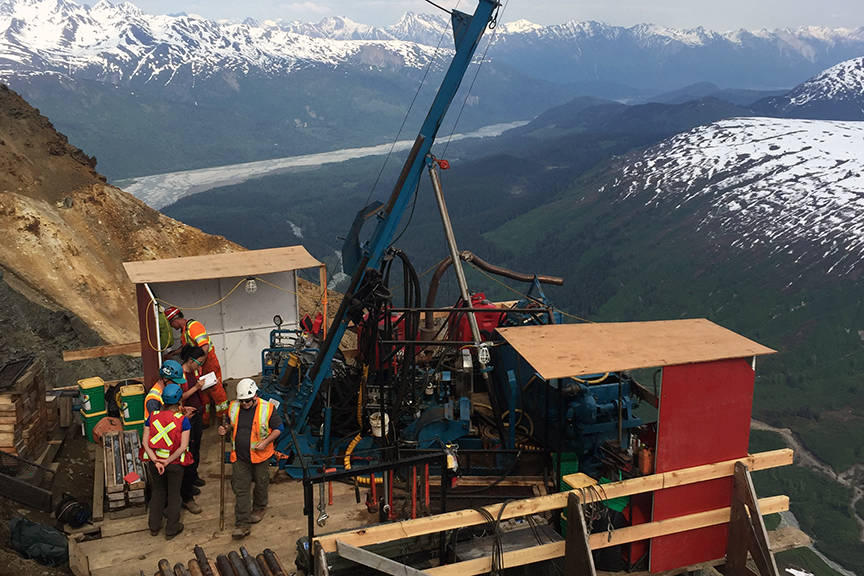Gov. Mike Dunleavy and top staff made a visit to a controversial mining project north of Haines earlier this month, and met privately with representatives from the company which owns the mine, Constantine Metal Resources Ltd.
Dunleavy, along with his chief of staff Ben Stevens and Department of Environmental Conservation Commissioner Jason Brune were flown by Constantine company helicopter to the site, roughly 35 miles north of Haines, on Sept. 9, according to vice president of community and external affairs for Constantine, Liz Cornejo.
The governor and his staff met only with representatives from Constantine, save for a brief, 10-minute visit with Haines Mayor Janice Hill at the Haines airport, according to the Chilkat Valley News.
This concerned some citizens of the area who have been opposed to the project.
“What state elected official shows up to a small town, unannounced, with a regulatory oversight official to visit a large corporate interest who is working on a project that could wipe out the town’s several thousand year old way of life, and can’t even take an hour or two to visit with the elected officials of the town?” Haines resident Michelle LaBrosse wrote in an email to the Empire.
The site, known as the Palmer Project, has been the source of controversy for years. Some local community members are concerned that runoff from the mine will endanger salmon and bald eagle habitat in the region.
In 2017, the tribal government of Klukwan sued the Bureau of Land Management, the federal agency which oversees permitting for mineral exploration, for failing to account for environmental risks resulting from such exploration.
In March this year, a federal judge ruled that BLM did not factor in future impacts of mining when issuing a permit.
Following that ruling, Constantine applied for wastewater discharge permits from the State of Alaska for activities related to mine exploration. Public comment on that application was held April 16-May 30, during which time environmental groups submitted a number of objections to the permit.
Gershon Cohen, director of Alaska Clean Water Advocacy told the Empire Constantine’s permit would allow the company to, “release hundreds of thousands of gallons of contaminated water every day that would have to be treated.”
How the company had proposed to treat that water was by storing it in settling ponds, according to a company document.
“What they want to do to treat it is just literally put it into a settling pond,” Cohen said, “which may remove some of the fine particles but which will not remove explosives residue, it will not remove drilling mud residues which are hydrocarbons. … The entire treatment system is bogus to begin with.”
The Alaska Department of Environmental Conservation issued water discharge permits to Constantine on July 17, but remanded, or revoked, that permit on Sept. 9, the same day the governor made his visit.
The permit was remanded following a decision in the federal Ninth Circuit Court (Hawai’i Wildlife Fund v. County of Maui) which said that a party needs a federal National Pollutant Discharge Elimination System (NPDES) permit in order to discharge pollutants into navigable waters.
The Palmer Project site is above Glacier Creek, a tributary to the Klehini River which in turn flows into the Chilkat River.
Federal NPDES permits are obtained through the Environmental Protection Agency and have more stringent standards than permits issued by the state, according to Cohen.
Thomas Morphet, a member of the Haines Borough Assembly, told the Empire in a phone interview Wednesday that DEC has said in the past that their purpose is to help companies get their permits.
“DEC serves more as an assistant coach than it does a referee,” Morphet said.
Morphet said he only learned of the governor’s visit after the fact, and while he wasn’t particularly aggrieved, he was a little surprised.
“We were surprised to hear about it after the fact,” Morphet said. “If the governor had full confidence in what he was doing, he would at least meet with the media, talked to the people.”
The Empire was not able to reach mayor Hill for comment, but did speak to members of the Haines Assembly.
“I had no idea he was coming,” said Sean Maidy, also on the Haines Assembly. “I didn’t know about it until after the fact. I would’ve really like to have been involved.”
According to Dunleavy’s press secretary Matt Shuckerow, the visit consisted of an “aerial site tour of where the future underground mine would be located, a brief touch down and on the ground camp visit,” Shuckerow said in an email.
Shuckerow told the Empire Wednesday that the governor had a limited amount of time on the ground in Haines and that he used that time to discuss the positive local impact a mine could have.
“The governor is for responsible resource development,” Shuckerow said.
• Contact reporter Peter Segall at 523-2228 or psegall@juneauempire.com.


